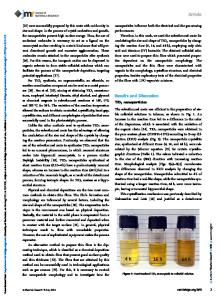Titanium dioxide thin films for next-generation memory devices
- PDF / 695,979 Bytes
- 13 Pages / 584.957 x 782.986 pts Page_size
- 19 Downloads / 353 Views
Kyung Min Kim Semiconductor Laboratory, Samsung Advanced Institute of Technology, Gyeonggi-Do 446-712, Korea
Doo Seok Jeong Electronic Materials Research Center, Korea Institute of Science and Technology, Seoul 130-650, Korea
Woojin Jeon, Kyung Jean Yoon, and Cheol Seong Hwanga) Department of Materials Science and Engineering, WCU Hybrid Materials Program, Seoul National University, Seoul 151-744, Korea; and Inter-university Semiconductor Research Center, Seoul National University, Seoul 151-744, Korea (Received 13 May 2012; accepted 20 June 2012)
The synthesis, structure, and electrical performances of titanium dioxide (TiO2 and also doped TiO2) thin films, a capacitor dielectric for dynamic random access memory (DRAM) and a resistance switching material in resistance switching RAM (ReRAM), are reviewed. The three-dimensionality of these structures and the extremely small feature sizes (,20 nm) of these memory devices require the synthesis method of TiO2-based layers to exhibit high degree of conformality. Atomic layer deposition is, therefore, the method of choice in respect of film growth for these applications. The unique arrangement of the TiO6-octahedra in the rutile structure, which results in the value for dielectric constant of the dielectric layer, er (.100), makes the material especially attractive as the capacitor dielectric layer in DRAM. Removing some of the oxygen ions from the rutile structure and arranging the resulting oxygen vacancies on a specific crystallographic plane results in the so called Magnéli phase materials, which show distinctive conducting semiconductor or metallic characteristics. External electrical stimuli can cause the repeated formation and rupture of conducting channels that consist of these Magnéli phase materials in the insulating TiO2 matrix, and this aspect makes the material a very feasible choice for applications in ReRAM. This article reviews the material properties, fabrication process, integration issues, and prospect of TiO2 films for these applications.
I. INTRODUCTION
The miniaturization (or scaling) of switching and data storing elements, such as transistors and capacitors, in semiconductor devices according to Moore’s law has been the major impetus for the continued and very successful growth of the semiconductor industry and various branches of information technology. However, the continuously decreased feature size of the devices is already reaching its practical and physical limitations (;10 nm), so different strategies are urgently needed. The practical limitations can be summarized by the ever-increasing and already extremely expensive patterning processes required as scaling progresses, while the physical issues arise from the literally countable number of electrons present in transistors at this size scale. When the number of electrons becomes countable quantum mechanical uncertainty can a)
Address all correspondence to this author. e-mail: [email protected] DOI: 10.1557/jmr.2012.231 J. Mater. Res., Vol. 28, No. 3, Feb 14, 2013
http://journals.cambridge.o
Data Loading...










